Orion (spacecraft)
 The Orion spacecraft for Artemis 1, October 2020 | |
| Manufacturer |
|
|---|---|
| Operator | NASA[1] |
| Applications | Crewed exploration beyond LEO[2] |
| Specifications | |
| Spacecraft type | Crewed |
| Launch mass |
|
| Dry mass |
|
| Payload capacity | 220 lb (100 kg) return payload |
| Crew capacity | 2–6[4] |
| Volume |
|
| Power | Solar |
| Regime | Lunar Transfer Orbit, lunar orbit |
| Design life | 21.1 days[3] |
| Dimensions | |
| Length | 10 feet 10 inches (3.30 m) |
| Diameter | 16 feet 6 inches (5.03 m) |
| Production | |
| Status | In production |
| On order | 6-12 (+3 ordered before 2019) [6] |
| Built | 4 |
| Launched | 1 |
| Maiden launch | December 5, 2014 |
| Related spacecraft | |
| Derived from |
|
 | |
Orion (officially Orion Multi-Purpose Crew Vehicle or Orion MPCV) is a class of partially reusable space capsules to be used in NASA's human spaceflight programs. The spacecraft consists of a Crew Module (CM) designed by Lockheed Martin and the European Service Module (ESM) manufactured by Airbus Defence and Space. Capable of supporting a crew of six beyond low Earth orbit, Orion can last up to 21 days undocked and up to six months docked. It is equipped with solar panels, an automated docking system, and glass cockpit interfaces modeled after those used in the Boeing 787 Dreamliner. A single AJ10 engine provides the spacecraft's primary propulsion, while eight R-4D-11 engines, and six pods of custom reaction control system engines developed by Airbus, provide the spacecraft's secondary propulsion. Although compatible with other launch vehicles, Orion is primarily intended to launch atop a Space Launch System (SLS) rocket, with a tower launch escape system.
Orion was originally conceived in the early 2000s by Lockheed Martin as a proposal for the Crew Exploration Vehicle (CEV) to be used in NASA's Constellation program. Lockheed Martin's proposal defeated a competing proposal by Northrop Grumman and was selected by NASA in 2006 to be the CEV. Originally designed with a service module featuring a new "Orion Main Engine" and a pair of circular solar panels, the spacecraft was to be launched atop the Ares I rocket. Following the cancellation of the Constellation program in 2010, Orion was heavily redesigned for use in NASA's Journey to Mars initiative; later named Moon to Mars. The SLS replaced the Ares I as Orion's primary launch vehicle, and the service module was replaced with a design based on the European Space Agency's Automated Transfer Vehicle. A development version of Orion's CM was launched in 2014 during Exploration Flight Test-1, while at least four test articles have been produced. As of 2020, three flight-worthy Orion spacecraft are under construction, with an additional one ordered,[a] for use in NASA's Artemis program; the first of these is due to be launched in 2021 on Artemis 1. On November 30, 2020, it was reported that NASA and Lockheed Martin had found a failure with a component in one of the Orion spacecraft's power data units but NASA later clarified that it does not expect the issue to affect the Artemis 1 launch date.[9][10]
Spacecraft description[]
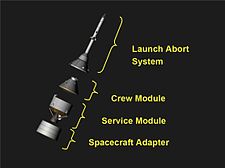
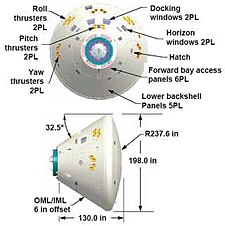

Orion uses the same basic configuration as the Apollo command and service module (CSM) that first took astronauts to the Moon, but with an increased diameter, updated thermal protection system, and a host of other modern technologies. It will be capable of supporting long-duration deep space missions with up to 21 days of active crew time plus 6 months quiescent spacecraft life.[11] During the quiescent period crew life support would be provided by another module, such as the proposed Deep Space Habitat. The spacecraft's life support, propulsion, thermal protection, and avionics systems can be upgraded as new technologies become available.[12]
The Orion spacecraft includes both crew and service modules, a spacecraft adapter and an emergency launch abort system. The Orion's crew module is larger than Apollo's and can support more crew members for short or long-duration missions. The European service module propels and powers the spacecraft as well as storing oxygen and water for astronauts, Orion relies on solar energy rather than fuel cells which allow for longer missions.
Crew module (CM)[]
It has been suggested that this section be split out into another article titled . (Discuss) (November 2020) |
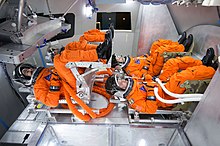

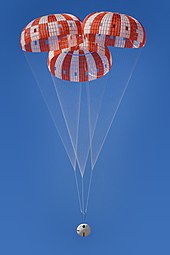
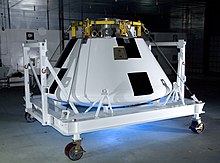
The Orion crew module (CM) is a reusable transportation capsule that provides a habitat for the crew, provides storage for consumables and research instruments, and contains the docking port for crew transfers.[12][13][14] The crew module is the only part of the spacecraft that returns to Earth after each mission and is a 57.5° truncated cone shape with a blunt spherical aft end, 5.02 meters (16 ft 6 in) in diameter and 3.3 meters (10 ft 10 in) in length,[15] with a mass of about 8.5 metric tons (19,000 lb). It was manufactured by the Lockheed Martin Corporation at Michoud Assembly Facility in New Orleans.[16][17] It will have 50% more volume than the Apollo capsule and will carry four to six astronauts.[18] After extensive study, NASA has selected the Avcoat ablator system for the Orion crew module. Avcoat, which is composed of silica fibers with a resin in a honeycomb made of fiberglass and phenolic resin, was formerly used on the Apollo missions and on the Space Shuttle orbiter for early flights.[19]
Orion's CM will use advanced technologies, including:
- Glass cockpit digital control systems derived from those of the Boeing 787.[20]
- An "autodock" feature, like those of Progress, the Automated Transfer Vehicle, and Dragon 2, with provision for the flight crew to take over in an emergency. Prior US spacecraft have all been docked by the crew.
- Improved waste-management facilities, with a miniature camping-style toilet and the unisex "relief tube" used on the Space Shuttle.
- A nitrogen/oxygen (N
2/O
2) mixed atmosphere at either sea level (101.3 kPa or 14.69 psi) or reduced (55.2 to 70.3 kPa or 8.01 to 10.20 psi) pressure. - Far more advanced computers[clarification needed] than on prior crew vehicles.[citation needed]
The CM will be built of aluminium-lithium alloy. The reusable recovery parachutes will be based on the parachutes used on both the Apollo spacecraft and the Space Shuttle Solid Rocket Boosters, and will be constructed of Nomex cloth. Water landings will be the exclusive means of recovery for the Orion CM.[21][22]
To allow Orion to mate with other vehicles, it will be equipped with the NASA Docking System. The spacecraft will employ a Launch Escape System (LES) along with a "Boost Protective Cover" (made of fiberglass), to protect the Orion CM from aerodynamic and impact stresses during the first 2+1⁄2 minutes of ascent. Its designers claim that the MPCV is designed to be 10 times safer during ascent and reentry than the Space Shuttle.[23] The CM is designed to be refurbished and reused. In addition, all of Orion's component parts have been designed to be as modular as possible, so that between the craft's first test flight in 2014 and its projected Mars voyage in the 2030s, the spacecraft can be upgraded as new technologies become available.[12]
As of 2019, the Spacecraft Atmospheric Monitor is planned to be used in the Orion CM.[24]
European Service Module (ESM)[]
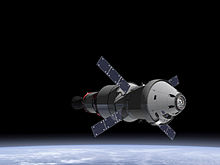
In May 2011 the ESA director general announced a possible collaboration with NASA to work on a successor to the Automated Transfer Vehicle (ATV).[25] On June 21, 2012, Airbus Defence and Space announced that they had been awarded two separate studies, each worth €6.5 million, to evaluate the possibilities of using technology and experience gained from ATV and Columbus related work for future missions. The first looked into the possible construction of a service module which would be used in tandem with the Orion CM.[26] The second examined the possible production of a versatile multi purpose orbital vehicle.[27]
On November 21, 2012, the ESA decided to develop an ATV-derived service module for Orion.[28] The service module is being manufactured by Airbus Defence and Space in Bremen, Germany.[29] NASA announced on January 16, 2013, that the ESA service module will first fly on Artemis 1, the debut launch of the Space Launch System.[30]
Testing of the European service module began in February 2016, at the Space Power Facility.[31]
On February 16, 2017, a €200m contract was signed between Airbus and the European Space Agency for the production of a second European service module for use on the first crewed Orion flight, Artemis 2.[32]
On 26 October 2018 the first unit for Artemis 1 was assembled in full at Airbus Defence and Space's factory in Bremen.[33]
Launch Abort System (LAS)[]
In the event of an emergency on the launch pad or during ascent, a Launch Abort System (LAS) will separate the crew module from the launch vehicle using three solid rocket motors: an abort motor (AM),[34] an attitude control motor (ACM), and a jettison motor (JM). The AM provides the thrust needed to accelerate the capsule, while the ACM is used to point the AM[35] and the jettison motor separates the LAS from the crew capsule.[36] On July 10, 2007, Orbital Sciences, the prime contractor for the LAS, awarded Alliant Techsystems (ATK) a $62.5 million sub-contract to "design, develop, produce, test and deliver the launch abort motor," which uses a "reverse flow" design.[37] On July 9, 2008, NASA announced that ATK had completed construction of a vertical test stand at a facility in Promontory, Utah to test launch abort motors for the Orion spacecraft.[38] Another long-time space motor contractor, Aerojet, was awarded the jettison motor design and development contract for the LAS. As of September 2008, Aerojet has, along with team members Orbital Sciences, Lockheed Martin and NASA, successfully demonstrated two full-scale test firings of the jettison motor. This motor is used on every flight, as it pulls the LAS tower away from the vehicle after both a successful launch and a launch abort.[39]
History[]

The Orion MPCV was announced by NASA on May 24, 2011.[40] Its design is based on the Crew Exploration Vehicle from the canceled Constellation program,[41] which had been a 2006 NASA contract award to Lockheed Martin.[42] The command module is being built by Lockheed Martin at the Michoud Assembly Facility,[43] while the Orion service module is being built by Airbus Defence and Space with funding from the European Space Agency.[30][44]The MPCV's first uncrewed test flight (EFT-1) was launched atop a Delta IV Heavy rocket on December 5, 2014, and lasted 4 hours and 24 minutes before landing at its target in the Pacific Ocean.[45][46][47][48]
Funding history and planning[]
For fiscal years 2006 through 2020, the Orion expended funding totaling $18,764 million in nominal dollars. This is equivalent to $21,477 million adjusting to 2020 dollars using the NASA New Start Inflation Indices.[49]
For fiscal year 2021, $1,401 million[50] was requested for the Orion program.
| Fiscal year | Funding (nominal, in $millions) | Funding (In 2020 $, in $millions)[49] | Line item name |
|---|---|---|---|
| 2006 | 839.2 | 1,122.5 | CEV[51] |
| 2007 | 714.5 | 920.2 | CEV[52] |
| 2008 | 1,174.1 | 1,460.1 | CEV[53] |
| 2009 | 1,747.9 | 2,133.1 | CEV[53] |
| 2010 | 1,640 | 1,974.4 | CEV[53] |
| 2011 | 1,196.0 | 1,417.4 | MPCV[54] |
| 2012 | 1,200 | 1,406.7 | Orion MPCV[55] |
| 2013 | 1,138 | 1,314.3 | Orion MPCV[56] |
| 2014 | 1,197 | 1,355.8 | Orion Program[57] |
| 2015 | 1,190.2 | 1,321.5 | Orion Program[58] |
| 2016 | 1,270 | 1,390.9 | Orion Program[59] |
| 2017 | 1,350.0 | 1,451.4 | Orion[60] |
| 2018 | 1,350.0 | 1,416.9 | Orion[61] |
| 2019 | 1,350.0 | 1,385.2 | Orion[50] |
| 2020 | 1,406.7 | 1,406.7 | Orion[62] |
| 2021 | 1,406.7 | 1,406.7 | Orion[63] |
| 2006-2020 | Total $18,764 | Total $21,477 |
Excluded from the prior Orion costs are:
- Most costs "for production, operations, or sustainment of additional crew capsules, despite plans to use and possibly enhance this capsule after 2021";[64] production and operations contracts were awarded going into fiscal year 2020[65]
- Costs of the first service module and spare parts, which are provided by ESA[66] for the test flight of Orion (about US$1 billion)[67]
- Costs to assemble, integrate, prepare and launch the Orion and its launcher (funded under the NASA Ground Operations Project,[68] currently about $400M[69] per year)
- Costs of the launcher, the SLS, for the Orion spacecraft
For 2021 to 2025, NASA estimates[70] yearly budgets for Orion from $1.4 to $1.1 billion. In late 2015, the Orion program was assessed at a 70% confidence level for its first crewed flight by 2023.[71][72][73]
There are no NASA estimates for the Orion program recurring yearly costs once operational, for a certain flight rate per year, or for the resulting average costs per flight. However, a production and operations contract[74] awarded to Lockheed Martin in 2019 indicated NASA will pay the prime contractor $900M for the first three Orion capsules and $633M for the following three.[75] In 2016, the NASA manager of exploration systems development said that Orion, SLS, and supporting ground systems should cost "US$2 billion or less" annually.[76] NASA will not provide the cost per flight of Orion and SLS, with associate administrator William H. Gerstenmaier stating "costs must be derived from the data and are not directly available. This was done by design to lower NASA's expenditures" in 2017.[77]
Ground test articles, mockups, and boilerplates[]
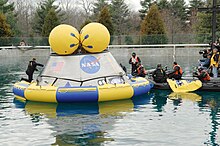
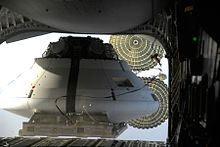
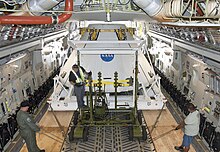
- Space Vehicle Mockup Facility (SVMF) in Johnson Space Center, includes a full-scale Orion capsule mock-up for astronaut training.[78]
- MLAS An Orion boilerplate was used in the MLAS test launch.
- Ares-I-X The Orion Mass Simulator was used on the Ares I-X flight test.
- Pad Abort 1 An Orion boilerplate was used for the Pad Abort 1 flight test, the LAS was fully functional, the boilerplate was recovered
- Ascent Abort-2 An Orion boilerplate was used for the Ascent Abort 2 flight test, the LAS was fully functional, the boilerplate was discarded
- The Boilerplate Test Article (BTA) underwent splashdown testing at the Langley Research Center. This same test article has been modified to support Orion Recovery Testing in stationary and underway recovery tests.[79] The BTA contains over 150 sensors to gather data on its test drops.[80] Testing of the 18,000-pound (8,200 kg) mockup ran from July 2011 to January 6, 2012.[81]
- The Ground Test Article (GTA) stack, located at Lockheed Martin in Denver, is undergoing vibration testing.[82] It is made up by the Orion Ground Test Vehicle (GTV) combined with its Launch Abort System (LAS). Further testing will see the addition of service module simulator panels and Thermal Protection System (TPS) to the GTA stack.[83]
- The Drop Test Article (DTA), also known as the Drop Test Vehicle (DTV) underwent test drops at the US Army's Yuma Proving Ground in Arizona from an altitude of 25,000 feet (7,600 m).[83] Testing began in 2007. Drogue chutes deploy around 20,000 and 15,000 feet (6,100 and 4,600 m). Testing of the staged parachutes includes the partial opening and complete failure of one of the three main parachutes. With only two chutes deployed the DTA lands at 33 feet per second (10 m/s), the maximum touchdown speed for Orion's design.[84] The drop test program has had several failures in 2007, 2008, and 2010,[85] resulting in new DTV being constructed. The landing parachute set is known as the Capsule Parachute Assembly System (CPAS).[86] With all parachutes functional, a landing speed of 17 mph (27 km/h) was achieved.[87] A third test vehicle, the PCDTV3, was successfully tested in a drop on April 17, 2012.[88]
Variants[]
Orion Crew Exploration Vehicle (CEV)[]
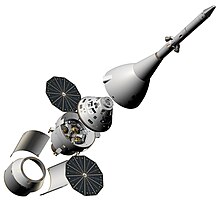
Orion CEV design as of 2009.
The idea for a Crew Exploration Vehicle (CEV) was announced on January 14, 2004, as part of the Vision for Space Exploration after the Space Shuttle Columbia accident.[89] The CEV effectively replaced the conceptual Orbital Space Plane (OSP), a proposed replacement for the Space Shuttle. A design competition was held, and the winner was the proposal from a consortium led by Lockheed Martin. It was later named "Orion" after the stellar constellation and mythical hunter of the same name,[90] and became part of the Constellation program under NASA administrator Sean O'Keefe.
Constellation proposed using the Orion CEV in both crew and cargo variants to support the International Space Station and as a crew vehicle for a return to the Moon. The crew/command module was originally intended to land on solid ground on the US west coast using airbags but later changed to ocean splashdown, while a service module was included for life support and propulsion.[21] With a diameter of 5 meters (16 ft 5 in) as opposed to 3.9 meters (12 ft 10 in), the Orion CEV would have provided 2.5 times greater volume than the Apollo CM.[91] The service module was originally planned to use liquid methane (LCH4) as its fuel, but switched to hypergolic propellants due to the infancy of oxygen/methane-powered rocket technologies and the goal of launching the Orion CEV by 2012.[92][93][94]
The Orion CEV was to be launched on the Ares I rocket to low Earth orbit, where it would rendezvous with the Altair lunar lander launched on a heavy-lift Ares V launch vehicle for lunar missions.
Environmental testing[]
NASA performed environmental testing of Orion from 2007 to 2011 at the Glenn Research Center Plum Brook Station in Sandusky, Ohio. The Center's Space Power Facility is the world's largest thermal vacuum chamber.[95]
Launch abort system (LAS) testing[]
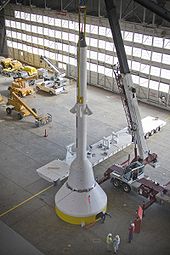
ATK Aerospace successfully completed the first Orion Launch Abort System (LAS) test on November 20, 2008. The LAS motor could provide 500,000 lbf (2,200 kN) of thrust in case an emergency situation should arise on the launch pad or during the first 300,000 feet (91 km) of the rocket's climb to orbit.[96]
On March 2, 2009, a full size, full weight command module mockup (pathfinder) began its journey from the Langley Research Center to the White Sands Missile Range, New Mexico, for at-gantry launch vehicle assembly training and for LAS testing.[97] On May 10, 2010, NASA successfully executed the LAS PAD-Abort-1 test at White Sands New Mexico, launching a boilerplate (mock-up) Orion capsule to an altitude of approximately 6,000 feet (1,800 m). The test used three solid-fuel rocket motors – the main thrust motor, an attitude control motor and the jettison motor.[98]
Splashdown recovery testing[]
In 2009, during the Constellation phase of the program, the Post-landing Orion Recovery Test (PORT) was designed to determine and evaluate methods of crew rescue and what kind of motions the astronaut crew could expect after landing, including conditions outside the capsule for the recovery team. The evaluation process supported NASA's design of landing recovery operations including equipment, ship and crew needs.
The PORT Test used a full-scale boilerplate (mock-up) of NASA's Orion crew module and was tested in water under simulated and real weather conditions. Tests began March 23, 2009, with a Navy-built, 18,000-pound (8,200 kg) boilerplate in a test pool. Full sea testing ran April 6–30, 2009, at various locations off the coast of NASA's Kennedy Space Center with media coverage.[99]
Cancellation of Constellation program[]
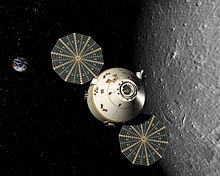
On May 7, 2009, the Obama administration enlisted the Augustine Commission to perform a full independent review of the ongoing NASA space exploration program. The commission found the then-current Constellation Program to be woefully under-budgeted with significant cost overruns, behind schedule by four years or more in several essential components, and unlikely to be capable of meeting any of its scheduled goals.[100][101] As a consequence, the commission recommended a significant re-allocation of goals and resources. As one of the many outcomes based on these recommendations, on October 11, 2010, the Constellation program was canceled, ending development of the Altair, Ares I, and Ares V. The Orion Crew Exploration Vehicle survived the cancellation and was transferred to be launched on the Space Launch System.[102]
Orion Multi-Purpose Crew Vehicle (MPCV)[]
The Orion development program was restructured from three different versions of the Orion capsule, each for a different task,[103] to the development of the MPCV as a single version capable of performing multiple tasks.[5] On December 5, 2014, a developmental Orion spacecraft was successfully launched into space and retrieved at sea after splashdown on the Exploration Flight Test-1 (EFT-1).[104][105]
Orion splashdown recovery testing[]
Before EFT-1 in December 2014, several preparatory vehicle recovery tests were performed, which continued the "crawl, walk, run" approach established by PORT. The "crawl" phase was performed August 12–16, 2013, with the Stationary Recovery Test (SRT).[citation needed] The Stationary Recovery Test demonstrated the recovery hardware and techniques that were to be employed for the recovery of the Orion crew module in the protected waters of Naval Station Norfolk utilizing the LPD-17 type USS Arlington as the recovery ship.[106]
The "walk" and "run" phases were performed with the Underway Recovery Test (URT). Also utilizing an LPD 17 class ship, the URT was performed in more realistic sea conditions off the coast of California in early 2014 to prepare the US Navy / NASA team for recovering the Exploration Flight Test-1 (EFT-1) Orion crew module. The URT tests completed the pre-launch test phase of the Orion recovery system.[citation needed]
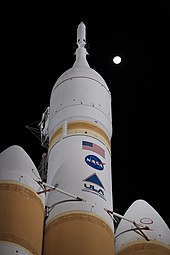
Orion Lite[]
History[]
Orion Lite is an unofficial name used in the media for a lightweight crew capsule proposed by Bigelow Aerospace in collaboration with Lockheed Martin. It was to be based on the Orion spacecraft that Lockheed Martin was developing for NASA. It would be a lighter, less capable and cheaper version of the full Orion.[107]
The intention of designing Orion Lite would be to provide a stripped-down version of the Orion that would be available for missions to the International Space Station earlier than the more capable Orion, which is designed for longer duration missions to the Moon and Mars.[108]
Bigelow had begun working with Lockheed Martin in 2004. A few years later Bigelow signed a million-dollar contract to develop "an Orion mockup, an Orion Lite",[109] in 2009.[107]
The proposed collaboration between Bigelow and Lockheed Martin on the Orion Lite spacecraft has ended.[when?] Bigelow began work with Boeing on a similar capsule, the CST-100, which has no Orion heritage, and was selected under NASA's Commercial Crew Development (CCDev) program to transport crew to the ISS.[citation needed]
Design[]
Orion Lite's primary mission would be to transport crew to the International Space Station, or to private space stations such as the planned B330 from Bigelow Aerospace. While Orion Lite would have the same exterior dimensions as the Orion, there would be no need for the deep space infrastructure present in the Orion configuration. As such, the Orion Lite would be able to support larger crews of around 7 people as the result of greater habitable interior volume and the reduced weight of equipment needed to support an exclusively low-Earth-orbit configuration.[110]
Recovery[]
In order to reduce the weight of Orion Lite, the more durable heat shield of the Orion would be replaced with a lighter weight heat shield designed to support the lower temperatures of Earth atmospheric re-entry from low Earth orbit. Additionally, the current proposal calls for a mid-air retrieval, wherein another aircraft captures the descending Orion Lite module.[citation needed] To date, such a retrieval method has not been employed for crewed spacecraft, although it has been used with satellites.[111]
Flights[]
MLAS[]
MLAS was a test flight of the Max Launch Abort System (MLAS).
Ares I-X[]
Ares I-X was a test flight of the Ares rocket. It was launched in 2009 shortly after the program was canceled.
Pad Abort-1[]
Pad Abort-1 (PA-1) was a flight test of the Orion Launch Abort System (LAS).
Exploration Flight Test-1[]
At 7:05 AM EST on December 5, 2014, the Orion capsule was launched atop a Delta IV Heavy rocket for its first test flight, and splashed down in the Pacific Ocean about 4.5 hours later. Although it was not crewed, the two-orbit flight was NASA's first launch of a human-rated vehicle since the retirement of the Space Shuttle fleet in 2011. Orion reached an altitude of 3,600 mi (5,800 km) and speeds of up to 20,000 mph (8,900 m/s) on a flight that tested Orion's heat shield, parachutes, jettisoning components, and on-board computers.[112] Orion was recovered by USS Anchorage and brought to San Diego, California, for its return to Kennedy Space Center in Florida.[113]
Ascent Abort-2[]
Ascent Abort-2 (AA-2) was a test of the Launch Abort System (LAS) of NASA's Orion spacecraft.
The test followed Orion's Pad Abort-1 test in 2010, and Exploration Flight Test-1 in 2014 in which the capsule first flew in space. It precedes an uncrewed flight of Orion around the Moon as the Artemis 1 mission and paves the way for human use of Orion in subsequent missions of the Artemis program.
The test flight, which had been subject to several delays during Orion development, took place on July 2, 2019 at 07:00 local time (11:00 UTC). The flight was successful, and the launch abort system performed as designed.[114][115]
| Mission | Patch | Launch | Crew | Launch vehicle | Outcome | Duration |
|---|---|---|---|---|---|---|
| MLAS |  |
|
N/A | MLAS | Success | 57 seconds |
| Ares I-X |
|
N/A | Ares I-X | Success | ~6 minutes | |
| Pad Abort-1 |
|
N/A | Orion Launch Abort System (LAS) | Success | 95 seconds | |
| Exploration Flight Test-1 |
|
N/A |
|
Success | 4 hours 24 minutes | |
| Ascent Abort-2 |
|
N/A | Orion Abort Test Booster | Success | 3 minutes 13 seconds |
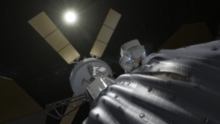
Canceled Asteroid Redirect Mission[]
The Asteroid Redirect Mission (ARM), also known as the Asteroid Retrieval and Utilization (ARU) mission and the Asteroid Initiative, was a space mission proposed by NASA in 2013. The Asteroid Retrieval Robotic Mission (ARRM) spacecraft would rendezvous with a large near-Earth asteroid and use robotic arms with anchoring grippers to retrieve a 4-meter boulder from the asteroid. A secondary objective was to develop the required technology to bring a small near-Earth asteroid into lunar orbit – "the asteroid was a bonus." There, it could be analyzed by the crew of the Orion EM-5 or EM-6 ARCM mission in 2026.[116]

Upcoming Missions[]
As of 2021, all Orion missions will be launched on the Space Launch System from Kennedy Space Center Launch Complex 39B. All full-scale flights will be into deep space with the first uncrewed flight of Artemis 1 entering a lunar orbit and the first crewed flight Artemis 2 going on a lunar flyby. Artemis 1 is planned to launch in 2021; however, in July 2016 a Government Accountability Office report cast doubt on the planned initial launch date and suggested that an early date may be counterproductive to the program.[117]
| Mission | Patch | Launch date | Crew | Launch vehicle | Duration |
|---|---|---|---|---|---|
| Artemis I | 
|
November 26, 2021 | N/A | SLS Block 1 Crew | ~25d |
| Artemis II | June 2023 | TBA | SLS Block 1 Crew | ~10d | |
| Artemis III | September 2024 | TBA | SLS Block 1 Crew | ~30d |
Proposed[]
A proposal curated by William H. Gerstenmaier before his 10 July 2019 reassignment[118] suggests four launches the crewed Orion spacecraft and logistical modules aboard the SLS Block 1B to the Gateway between 2024 and 2028.[119][120] The crewed Artemis 4 through 7 would launch yearly between 2025 and 2028,[121] testing in situ resource utilization and nuclear power on the lunar surface with a partially reusable lander. Artemis 7 would deliver in 2028 a crew of four astronauts to a surface lunar outpost known as the Lunar Surface Asset.[121] The Lunar Surface Asset would be launched by an undetermined launcher[121] and would be used for extended crewed lunar surface missions.[121][122][123][124] Another repair mission to the Hubble Space Telescope is also possible.[125]
| Mission | Launch date | Crew | Launch vehicle | Duration |
|---|---|---|---|---|
| Artemis IV | March 2026 | TBA | SLS Block 1B Crew | ~30d |
| Artemis V | 2026 | TBA | SLS Block 1B Crew | ~30d |
| Artemis VI | 2027 | TBA | SLS Block 1B Crew | ~30d |
| Artemis VII | 2028 | TBA | SLS Block 1B Crew | ~30d |

Potential Mars missions[]
The Orion capsule is designed to support future missions to send astronauts to Mars, probably to take place in the 2030s. Since the Orion capsule provides only about 2.25 m3 (79 cu ft) of living space per crew member,[126] the use of an additional Deep Space Habitat module featuring propulsion will be needed for long-duration missions. The complete spacecraft stack is known as the Deep Space Transport.[127] The habitat module will provide additional space and supplies, as well as facilitate spacecraft maintenance, mission communications, exercise, training, and personal recreation.[128] Some concepts for DSH modules would provide approximately 70.0 m3 (2,472 cu ft) of living space per crew member,[128] though the DSH module is in its early conceptual stage. DSH sizes and configurations may vary slightly, depending on crew and mission needs.[129] The mission may launch in the mid-2030s or late-2030s.[130]
List of vehicles[]
| Image | Serial | Status | Flights | Time in flight | Notes | Cat. | |
|---|---|---|---|---|---|---|---|

|
GTA | Active | 0 | None | Ground Test Article, used in ground tests of the Orion crew module design with mock service modules.[131][132] | ||
| Unknown | Retired | 1 | 57s | Boilerplate used in the July 2009 test launch of the Max Launch Abort System; did not have a service module. | |||
| CM/LAS | Expended | 1 | ~6m | Boilerplate used in Ares I-X launch; did not have a service module. | |||

|
Unknown | Retired | 1 | 2m, 15s | Boilerplate used in Pad Abort-1; did not have a service module.[133][134] | ||

|
001 | Retired | 1 | 4h, 24m, 46s | Vehicle used in Exploration Flight Test-1. First Orion to fly in space; did not have a service module.[135][136] | ||

|
STA | Active | 0 | None | Structural Test Article, used in structural testing of the complete Orion spacecraft design.[citation needed] | ||

|
Unknown | Expended | 1 | 3m, 13s | Boilerplate used in Ascent Abort-2; did not have a service module. Intentionally destroyed during the flight.[137][138] | ||

|
002 | Active | 0 | None | Vehicle to be used in Artemis 1.[136][139] | ||

|
003 | Under construction | 0 | None | Vehicle to be used in Artemis 2. First Orion planned to carry crew.[139] | ||

|
004 | Under construction | 0 | None | Vehicle to be used in Artemis 3.[139] Pressure vessel completed at Michoud in August 2021.[140] | ||
| Test vehicle Spaceflight vehicle |
See also[]
- List of crewed spacecraft – Wikipedia list article
- NASA Authorization Act of 2010
- Space capsule – Type of spacecraft
- Space policy of the Barack Obama administration
References[]
![]() This article incorporates public domain material from websites or documents of the National Aeronautics and Space Administration.
This article incorporates public domain material from websites or documents of the National Aeronautics and Space Administration.
- ^ "Preliminary Report Regarding NASA's Space Launch System and Multi-Purpose Crew Vehicle" (PDF). NASA. January 2011. Retrieved May 25, 2011.
- ^ "NASA Authorization Act of 2010". Thomas.loc.gov. Archived from the original on December 19, 2010. Retrieved November 20, 2010.
- ^ Bergin, Chris (July 10, 2012). "NASA ESD set key Orion requirement based on Lunar missions". NASASpaceFlight.com. Retrieved July 23, 2012.
- ^ Moskowitz, Clara (November 2014). "Deep Space or Bust". Scientific American. 311 (6): 20. Bibcode:2014SciAm.311f..20M. doi:10.1038/scientificamerican1214-20.
- ^ Jump up to: a b "Orion Quick facts" (PDF). NASA. August 4, 2014. Retrieved October 29, 2015.
- ^ "NASA Commits to Long-term Artemis Missions with Orion Production Contract". NASA. NASA. Retrieved April 18, 2020.
- ^ Foust, Jeff (September 24, 2019). "NASA awards long-term Orion production contract to Lockheed Martin". SpaceNews. Retrieved December 10, 2019.
The Orion Production and Operations Contract includes an initial order of three Orion spacecraft, for missions Artemis 3, 4 and 5, for $2.7 billion.
- ^ Clark, Stephen (November 29, 2019). "Earth observation, deep space exploration big winners in new ESA budget". Spaceflight Now. Archived from the original on December 10, 2019. Retrieved December 10, 2019.
ESA member states put up money for two Orion service modules at this week's summit in Seville. The power and propulsion modules will fly with NASA's Orion spacecraft carrying astronauts to the moon on the Artemis 3 and Artemis 4 missions...
- ^ (November 30, 2020). "Component failure in NASA's deep-space crew capsule could take months to fix". The Verge. Retrieved December 3, 2020.
- ^ (December 7, 2020). "Issue with Orion power distribution unit "We really don't think it's going to be a big impact on the final schedule for the Artemis I flight," @NASA's Ken Bowersox tells reporters". Retrieved December 9, 2020.
- ^ Peterson, L. (2009). "Environmental Control and Life Support System (ECLSS)" (PDF). ntrs.nasa.gov. Ames Research Center: NASA. Archived from the original on April 7, 2014. Retrieved April 7, 2014.
- ^ Jump up to: a b c "NASA Goes 'Green': Next Spacecraft to be Reusable – Orion Capsule". Space.com.
- ^ "NASA - A 21st Century-Style Return to the Moon". nasa.gov.
- ^ Bergin, Chris. "EFT-1 Orion completes assembly and conducts FRR". NASASpaceflight.com. Retrieved November 10, 2014.
- ^ "NASA – Orion Crew Exploration Vehicle" (PDF) (Press release). NASA. February 7, 2009. Retrieved February 7, 2009.
- ^ "Lockheed to build Nasa 'Moonship'". BBC News. August 31, 2006. Retrieved March 1, 2007.
- ^ LaNasa, Shannon (2021). "Michoud Tenants: Lockheed Martin". Marshall Space Flight Center. NASA. Retrieved June 27, 2021.
 This article incorporates text from this source, which is in the public domain.
This article incorporates text from this source, which is in the public domain.
- ^ "NASA Names New Crew Exploration Vehicle Orion" (Press release). NASA. August 22, 2006. Retrieved March 3, 2007.
- ^ "NASA Selects Material for Orion Spacecraft Heat Shield" (Press release). NASA Ames Research Center. April 7, 2009. Retrieved April 16, 2009.
- ^ Coppinger, Rob (October 6, 2006). "NASA Orion crew vehicle will use voice controls in Boeing 787-style Honeywell smart cockpit". Flight International. Retrieved October 6, 2006.
- ^ Jump up to: a b "Orion landings to be splashdowns – KSC buildings to be demolished". NASA SpaceFlight.com. August 5, 2007. Retrieved August 5, 2007.
- ^ "NASA Denies Making Orion Water Landing Decision – and Deleting Touchdowns on Land". NASA Watch. August 6, 2007. Retrieved November 23, 2010.
- ^ "NASA Announces Key Decision For Next Deep Space Transportation System". NASA. May 24, 2011. Retrieved May 25, 2011.
- ^ Hill, Denise (July 23, 2019). "S.A.M. Goes to Work Aboard ISS". NASA. Retrieved July 31, 2019.
- ^ "US and Europe plan new spaceship". BBC News. May 5, 2011. Archived from the original on May 6, 2011. Retrieved May 14, 2011.
- ^ "ATV evolution studies look at exploration, debris removal". Spaceflight Now. June 21, 2012. Retrieved June 23, 2012.
- ^ "Airbus Defence and Space awarded two ATV evolution studies from ESA". Astrium. June 21, 2012. Archived from the original on April 3, 2013. Retrieved June 23, 2012.
- ^ Bergin, Chris (November 21, 2012). "UK steps up, as ESA commit to ATV Service Module on NASA's Orion". NASASpaceFlight.com. Retrieved July 15, 2014.
- ^ "Multi Purpose Crew Vehicle – European Service Module for NASA's Orion programme". Airbus Defence and Space. Retrieved March 7, 2016.
- ^ Jump up to: a b "NASA Signs Agreement for a European-Provided Orion Service Module". nasa.gov. January 16, 2013. Archived from the original on March 28, 2014. Retrieved March 28, 2014.
- ^ Cody Zoller (December 1, 2015). "NASA to begin testing Orion's European Service Module". NASA SpaceFlight. Retrieved March 7, 2016.
- ^ Airbus Defence and Space wins 200 million euros ESA contract for second service module for NASA's Orion crewed space capsule Archived April 19, 2017, at the Wayback Machine. Airbus Defense and Space press release. February 16, 2017.
- ^ "Call for media: The European Service module meets Orion". European Space Agency. October 26, 2018.
- ^ "Mission to the Moon: How We'll Go Back – and Stay This Time". popularmechanics.com. Archived from the original on February 3, 2008. Retrieved February 8, 2008.
- ^ Mika McKinnon (mika.mckinnon@gmail.com) (December 4, 2014). "Meet Orion, NASA's New Deep Space Explorer". Space.io9.com. Retrieved October 31, 2016.
- ^ "Launch Abort System Jettison Motor | Aerojet Rocketdyne". Rocket.com. Archived from the original on January 25, 2016. Retrieved October 31, 2016.
- ^ "ATK Awarded Contract for Orion Launch Abort Motors". PRNewswire. Archived from the original on March 1, 2012.
- ^ "Orion's New Launch Abort Motor Test Stand Ready for Action". NASA.
- ^ Rhian, Jason (July 17, 2018). "Jettison Motor Readied For Integration Into Orion's LAS". spaceflightinsider.com. Spaceflight Insider. Retrieved July 1, 2019.
The jettison motor separates the LAS from the Orion capsule on its way to orbit.
- ^ Wall, Mike (May 24, 2011). "NASA Unveils New Spaceship for Deep Space Exploration". Space.com. Retrieved May 24, 2011.
- ^ Moen, Marina M. "Feasibility of Orion Crew Module Entry on Half of Available Propellant Due to Tank Isolation Fault". American Institute of Aeronautics and Astronautics. NASA Langley Research Center. hdl:2060/20110014641.
- ^ "NASA Selects Lockheed Martin To Be Orion Crew Exploration Vehicle Prime Contractor" (Press release). NASA. August 31, 2006. Retrieved August 31, 2006.
- ^ "Michoud Assembly Facility Lockheed Martin Webpage". NASA. Retrieved November 27, 2018.
- ^ "ESA workhorse to power NASA's Orion spacecraft / Research / Human Spaceflight / Our Activities / ESA". Esa.int. January 16, 2013. Retrieved July 15, 2014.
- ^ Bergin, Chris (March 15, 2014). "EFT-1 Orion slips to December – Allows military satellite to launch first". nasaspaceflight.com. NASAspaceflight.com. Archived from the original on March 28, 2014. Retrieved March 28, 2014.
- ^ Clark, Stephen (March 15, 2014). "Launch schedule shakeup delays Orion to December". spaceflightnow.com. Archived from the original on March 28, 2014. Retrieved March 28, 2014.
- ^ "Orion Exploration Flight Test-1". aerospaceguide.net. January 11, 2014. Archived from the original on March 28, 2014. Retrieved March 28, 2014.
- ^ Fountain, Henry (December 5, 2014). "NASA's Orion Spacecraft Splashes Down in Pacific After Test Flight". New York Times. Retrieved December 5, 2014.
- ^ Jump up to: a b "NASA FY19 Inflation Tables - to be utilized in FY20". National Aeronautics and Space Administration. p. Inflation Table. Retrieved May 10, 2020.
- ^ Jump up to: a b "FY 2021 President's Budget Request Summary" (PDF). National Aeronautics and Space Administration. p. DEXP-4. Retrieved May 10, 2020.
- ^ "FY 2008 Budget Estimates" (PDF). National Aeronautics and Space Administration. p. ESMD-25. Retrieved June 7, 2016.
- ^ "Fiscal Year 2009 Budget Estimates" (PDF). National Aeronautics and space Administration. p. iv. Retrieved June 7, 2016.
- ^ Jump up to: a b c "Fiscal Year 2010 Budget Estimates" (PDF). National Aeronautics and Space Administration. p. v. Retrieved June 7, 2016.
- ^ "FY 2013 President's Budget Request Summary" (PDF). National Aeronautics and Space Administration. p. BUD-4. Retrieved June 7, 2016.
- ^ "FY 2014 President's Budget Request Summary" (PDF). National Aeronautics and Space Administration. p. BUD-8. Retrieved June 7, 2016.
- ^ "FY 2015 President's Budget Request Summary" (PDF). National Aeronautics and Space Administration. p. BUD-5. Retrieved June 7, 2016.
- ^ "FY 2016 President's Budget Request Summary" (PDF). National Aeronautics and space Administration. p. BUD-5. Retrieved June 7, 2016.
- ^ "FY 2017 Budget Estimates" (PDF). nasa.gov. National Aeronautics and Space Administration. p. BUD-4. Retrieved January 1, 2019.
- ^ "FY 2018 Budget Estimates" (PDF). nasa.gov. National Aeronautics and Space Administration. p. BUD-3. Retrieved January 1, 2019.
- ^ "Public Law 115-31, 115th Congress" (PDF). congress.gov. p. 213.
- ^ "2018 Consolidated Appropriations Act" (PDF). congress.gov. p. 82.
- ^ "H.R.1158 - 116th Congress (2019-2020): Consolidated Appropriations Act, 2020". www.congress.gov. December 20, 2019. p. 250. Retrieved January 9, 2020.
- ^ "H.R.1158 - 116th Congress (2021-2021): Consolidated Appropriations Act, 2021" (PDF). rules.house.gov. December 21, 2020. p. 205. Retrieved December 29, 2020.
- ^ "NASA Actions Needed to Improve Transparency and Assess Long Term Affordability of Human Exploration Programs" (PDF). General Accounting Office. May 2014. p. 2. Retrieved June 7, 2016.
- ^ "NASA Commits to Long-term Artemis Missions with Orion Production Contract". NASA.gov. Retrieved July 26, 2020.
- ^ Smith, Marcia (January 17, 2013). "NASA-ESA Agreement on Orion Service Module is For Only One Unit Plus Spares". spacepolicyonline.com. Retrieved June 28, 2016.
- ^ Clark, Stephen (December 3, 2014). "ESA member states commit funding for Orion service module". spaceflightnow.com. Retrieved June 28, 2016.
- ^ "NASA's Ground Systems Development and Operations Program Completes Preliminary Design Review". National Aeronautics and Space Administration. Retrieved June 28, 2016.
- ^ "FY 2016 President's Budget Request Summary" (PDF). National Aeronautics and Space Administration. p. BUD-5. Retrieved June 28, 2016.
- ^ "NASA FY 2021 Budget Estimates" (PDF). NASA.gov. Retrieved July 26, 2020.
- ^ J. Foust (September 16, 2015). "First Crewed Orion Mission May Slip to 2023". Space News. Retrieved September 16, 2015.
- ^ Clark, Stephen (September 16, 2015). "Orion spacecraft may not fly with astronauts until 2023". spaceflightnow.com. Retrieved June 7, 2016.
- ^ Smith, Marcia (May 1, 2014). "Mikulski "Deeply Troubled" by NASA's Budget Request; SLS Won't Use 70 Percent JCL". spacepolicyonline.com. Retrieved June 7, 2016.
- ^ "Orion Production and Operations Contract". govtribe.com. Retrieved July 26, 2020.
- ^ Berger, Eric (September 24, 2019). "After 15 years of development, Lockheed wins new cost-plus contract for Orion; Originally, NASA had hoped for a fixed-price deal". ars.technica. Retrieved July 26, 2020.
- ^ Berger, Eric (August 19, 2016). "How much will SLS and Orion cost to fly? Finally, some answers". arstechnica.com. Retrieved January 1, 2019.
- ^ Berger, Eric (October 20, 2017). "NASA chooses not to tell Congress how much deep space missions cost". arstechnica.com. Retrieved January 1, 2019.
- ^ "NASA Extreme Makeover—Space Vehicle Mockup Facility". nasa.gov. Retrieved December 5, 2014.
- ^ "What Goes Up Must Come Down As Orion Crew Vehicle Development Continues". Space-travel.com. Retrieved July 15, 2014.
- ^ "Orion Continues to Make a Splash". Space-travel.com. Retrieved July 15, 2014.
- ^ "Orion Drop Test – Jan. 06, 2012". Space-travel.com. Retrieved July 15, 2014.
- ^ Bergin, Chris (November 6, 2011). "NASA managers approve EFT-1 flight as Orion pushes for orbital debut". NASASpaceFlight.com. Retrieved July 15, 2014.
- ^ Jump up to: a b Bergin, Chris (October 17, 2011). "Space-bound Orion taking shape – "Lunar Surface First" missions referenced". NASASpaceFlight.com. Retrieved July 15, 2014.
- ^ "NASA Conducts Orion Parachute Testing for Orbital Test Flight". Space-travel.com. Retrieved July 15, 2014.
- ^ Bergin, Chris (February 10, 2012). "Orion hoping for success with second generation parachute system". NASASpaceFlight.com. Retrieved July 15, 2014.
- ^ Bergin, Chris (February 26, 2012). "Orion PTV preparing for drop test on Wednesday – EFT-1 Orion progress". NASASpaceFlight.com. Retrieved July 15, 2014.
- ^ "NASA Conducts New Parachute Test for Orion". Space-travel.com. Retrieved July 15, 2014.
- ^ "Orion parachutes preparing for another milestone drop test on April 17 | NASASpaceFlight.com". www.nasaspaceflight.com. Retrieved August 26, 2015.
- ^ "President Bush Announces New Vision for Space Exploration Program" (Press release). White House Office of the Press Secretary. January 14, 2004. Retrieved September 1, 2006.
- ^ "Orion Spacecraft – Nasa Orion Spacecraft". aerospaceguide.net.
- ^ "NASA Names New Crew Exploration Vehicle Orion" (Press release). NASA. August 22, 2006. Retrieved April 17, 2010.
- ^ Handlin, Daniel; Bergin, Chris (October 11, 2006). "NASA sets Orion 13 for Moon Return". NASAspaceflight.com. Retrieved March 3, 2007.
- ^ Handlin, Daniel; Bergin, Chris (July 22, 2006). "NASA makes major design changes to CEV". NASAspaceflight.com. Retrieved March 3, 2007.
- ^ "NASA Names Orion Contractor". NASA. August 31, 2006. Retrieved September 5, 2006.
- ^ "NASA Glenn To Test Orion Crew Exploration Vehicle". SpaceDaily.
- ^ "NASA: Constellation Abort Test November 2008". Nasa.gov. December 11, 2008. Retrieved November 20, 2010.
- ^ "NASA Orion LAS Pathfinder". Nasa.gov. Retrieved November 20, 2010.
- ^ "NASA Completes Test of Orion Crew Capsule". foxnews.com. May 6, 2010. Retrieved April 6, 2013.
- ^ "NASA Orion PORT Test". Nasa.gov. March 25, 2009. Retrieved November 20, 2010.
- ^ Augustine Commission Final Report Published 22 Oct. 2009. Retrieved 14 Dec. 2014
- ^ NASA in Obama's Hands Archived December 22, 2015, at the Wayback Machine Information Addict Website, by Nathaniel Downes. Published 18 June 2012. Retrieved 14 Dec 2014
- ^ "Today – President Signs NASA 2010 Authorization Act". Universetoday.com. Retrieved November 20, 2010.
- ^ What is NASA's Constellation Program? archived from the original the original Sciences 360 Website, By Tenebris. Discussion of multiple version development of Orion capsule. Published Nov. 17, 2009. Retrieved July 5, 2014
- ^ "Orion Spacecraft Complete". NASA. October 30, 2014. Retrieved October 30, 2014.
- ^ Fountain, Henry (December 5, 2014). "NASA's Orion Spacecraft Splashes Down in Pacific After Test Flight". The New York Times. Retrieved December 5, 2014.
- ^ "NASA & US Navy Test Demonstrates Water Recovery of Orion Crew Capsule". Universetoday.com. Retrieved July 15, 2014.
- ^ Jump up to: a b Klamper, Amy (August 14, 2009). "Nevada Company Pitches 'Lite' Concept for NASA's New Spaceship". space.com. Retrieved October 17, 2020.
- ^ Klamper, Amy (August 14, 2009). "Company pitches 'lite' spaceship to NASA". NBC News. Retrieved September 7, 2009.
- ^ Bigelow still thinks big, The Space Review, 2010-11-01, accessed 2010-11-02. "[In October 2010] Bigelow revealed that he had been working with Lockheed Martin on a capsule concept in the 2004–2005 period. 'We engaged in a million-dollar contract a couple years after that with Lockheed, and they created for us an Orion mockup, an Orion Lite.'
- ^ Space Hotel Visionary Proposes Modified "Orion Lite" Spaceship for NASA: Bigelow Airspace's concept is for low Earth-orbit missions only, Popular Science, Jeremy Hsu, 14 August 2009
- ^ "Discoverer 14 – NSSDC ID: 1960-010A". NASA.
- ^ "NASA's New Orion Spacecraft Completes First Spaceflight Test". NASA.gov. Retrieved December 9, 2014.
- ^ "Orion Off-loaded for Trip Back to Florida". NASA.gov. Retrieved December 9, 2014.
- ^ Cawley, James (July 2, 2019). "Launch Abort System Demonstrates Ability to Pull Astronauts to Safety". nasa.gov. NASA. Retrieved July 2, 2019.
- ^ Strickland, Ashley (July 2, 2019). "NASA tests abort system for the Orion spacecraft that will carry humans to the moon in 2024". cnn.com. CNN. Retrieved July 2, 2019.
- ^ Jeff Foust (June 14, 2017). "NASA closing out Asteroid Redirect Mission". Space News. Retrieved September 9, 2017.
- ^ Berger, Eric (July 28, 2016). "A new, independent review of the Orion spacecraft is pretty damning". Ars Technica. Retrieved July 28, 2016.
- ^ Davenport, Christion (July 10, 2019). "Shakeup at NASA as space agency scrambles to meet Trump moon mandate". Washington Post. Retrieved July 10, 2019.
- ^ Berger 2019, "Developed by the agency's senior human spaceflight manager, Bill Gerstenmaier, this plan is everything Pence asked for—an urgent human return, a Moon base, a mix of existing and new contractors."
- ^ Foust 2019, "After Artemis 3, NASA would launch four additional crewed missions to the lunar surface between 2025 and 2028. Meanwhile, the agency would work to expand the Gateway by launching additional components and crew vehicles and laying the foundation for an eventual moon base."
- ^ Jump up to: a b c d "America to the Moon 2024" (PDF).
- ^ Berger 2019, "This decade-long plan, which entails 37 launches of private and NASA rockets, as well as a mix of robotic and human landers, culminates with a "Lunar Surface Asset Deployment" in 2028, likely the beginning of a surface outpost for long-duration crew stays."
- ^ Berger 2019, [Illustration] "NASA's "notional" plan for a human return to the Moon by 2024, and an outpost by 2028."
- ^ Independent report concludes 2033 human Mars mission is not feasible. Jeff Foust, Space News. 18 April 2019.
- ^ Foust, Jeff (June 15, 2020). "Hugging Hubble longer". The Space Review. Retrieved June 16, 2020.
- ^ "Preliminary Report Regarding NASA's Space Launch System and Multi-Purpose Crew Vehicle" (PDF). NASA. January 2011. Retrieved June 18, 2011.
- ^ NASA Unveils the Keys to Getting Astronauts to Mars and Beyond. Neel V. Patel, The Inverse. April 4, 2017.
- ^ Jump up to: a b Habitat for Long Duration Deep Space Missions Preliminary design proposal for DSH by Rucker & Thompson. Published 5 May 2012, retrieved 8 Dec. 2014
- ^ 2012 X-Hab Academic Innovation Challenge Progress Update Nasa DSH design news update. Published June 21, 2012, retrieved 8 Dec. 2014
- ^ [1]
- ^ Kremer, Ken (March 30, 2010). "3 Welds to Go for 1st Orion Pathfinder Vehicle". Universe Today. Archived from the original on March 10, 2020. Retrieved March 10, 2020.
...the very first pathfinder Orion manned capsule – the Crew Module – known as the Ground Test Article (GTA) [...] The GTA is the first full-sized, flight-like test article for Orion.
- ^ Bergin, Chris (November 14, 2011). "EFT-1 Orion receives hatch door – Denver Orion ready for Modal Testing". NASASpaceFlight.com. Archived from the original on March 10, 2020. Retrieved March 10, 2020.
As much as the Service Module (SM) design is still undergoing evaluation – which includes discussions about utilizing hardware from the European Space Agency's ATV (Automated Transfer Vehicle) – the test vehicle includes an Orion Ground Test Article (GTA), in a Launch Abort Vehicle (LAV) configuration, with installed ogives and a mock SM.
- ^ Dryden Flight Research Center (May 6, 2010). "Orion Pad Abort 1 Test a Spectacular Success". National Aeronautics and Space Administration (NASA). Archived from the original on March 10, 2020. Retrieved March 10, 2020.
The 500,000-lb. thrust abort motor rocketed the boilerplate crew module and its launch abort stack away from launch pad 32E at White Sands...
- ^ Pearlman, Robert (May 7, 2010). "NASA's Launch Abort Test Builds on 50 Years of Astronaut Escape Systems". Space.com. Archived from the original on March 10, 2020. Retrieved March 10, 2020.
The Pad Abort-1 (PA1) flight test, which flew a boilerplate 16-foot (4.9-meter) wide, 18,000-pound (8,160-kg) Orion capsule under a nearly 45-foot (13.7-meter)long launch abort system (LAS) tower [...] The flight lasted about 135 seconds from launch until the module touched down...
- ^ Dunn, Marcia (December 6, 2014). "NASA launches new Orion spacecraft and new era (w/ video)". Tampa Bay Times. Archived from the original on March 10, 2020. Retrieved March 10, 2020.
Friday's Orion — serial number 001 — lacked seats, cockpit displays and life-support equipment, but brought along bundles of toys and memorabilia...
- ^ Jump up to: a b Davis, Jason (December 5, 2014). "Orion Returns to Earth after Successful Test Flight". The Planetary Society. Archived from the original on March 10, 2020. Retrieved March 10, 2020.
As impressive as this flight was, this was just serial number 001 of Orion," he said. "Serial number 002—that one is going to be on the Space Launch System.
- ^ Clark, Stephen (July 1, 2019). "Critical abort test of NASA's Orion crew capsule set for Tuesday". Spaceflight Now. Archived from the original on March 10, 2020. Retrieved March 10, 2020.
"So 20 seconds after the LAS (launch abort system) jettisons from the crew module, we start ejecting, so the first pair comes out 20 seconds after the LAS is jettisoned, and then every 10 seconds until all 12 are ejected." The capsule is expected to tumble after the abort system jettisons, and it will impact the sea at 300 mph (480 kilometers per hour) around 7 miles (11 kilometers) offshore, and is designed to sink to the ocean floor, according to Reed.
- ^ Sloss, Philip (October 25, 2019). "NASA conducting data deep dive following July's Orion ascent abort test". NASASpaceFlight.com. Archived from the original on March 10, 2020. Retrieved March 10, 2020.
The Ascent Abort-2 test used a ballistic missile to accelerate a production-design LAS with a Crew Module shaped, highly-instrumented test lab to carefully picked flight condition where a full LAS abort sequence was executed. [...] impact with the water destroyed the test article.
- ^ Jump up to: a b c Vuong, Zen (December 3, 2014). "JPL joins NASA's first agency-wide social media event to highlight Thursday's Orion flight test". Pasadena Star-News. Archived from the original on March 10, 2020. Retrieved March 10, 2020.
Orion 002, 003 and 004 will become lessons that will further humanity in its quest to inhabit Mars and become Earth-independent. [...] "Orion tail number 003 has a special place in my heart," he said. "Four of my astronauts are going to climb into it and have an adventure of a lifetime...
- ^ https://www.nasa.gov/feature/next-generation-of-orion-spacecraft-in-production-for-future-artemis-missions
External links[]
| Wikimedia Commons has media related to Orion (spacecraft). |
- Orion (spacecraft)
- Crewed spacecraft
- Proposed spacecraft
- Deep Space Habitat
- Artemis program
- Vehicles introduced in 2014
- Reusable spacecraft
- Lunar Gateway
- NASA spacecraft





